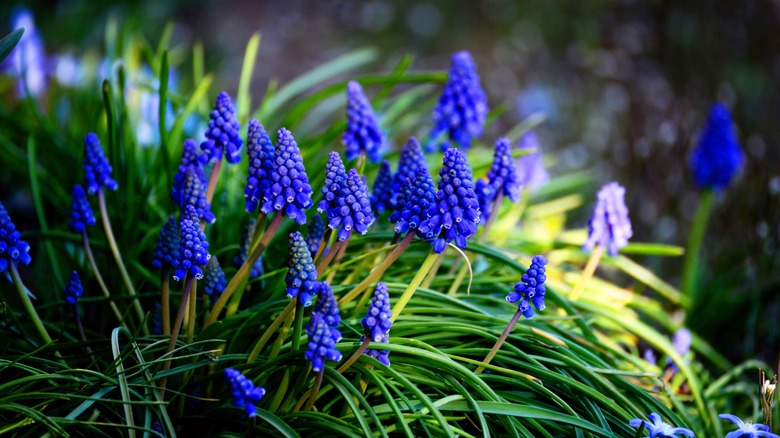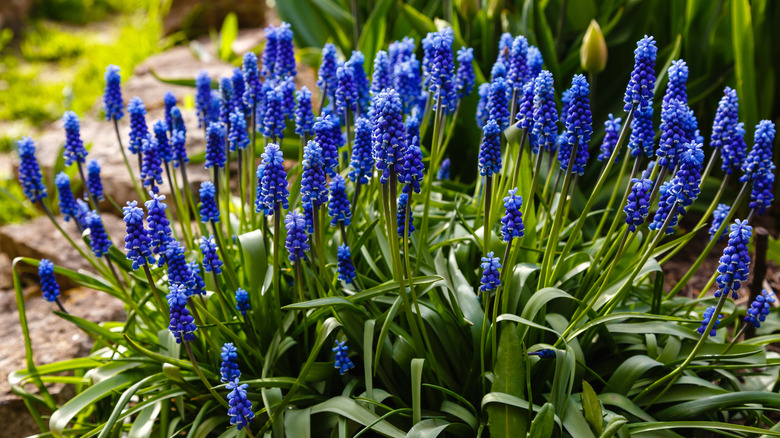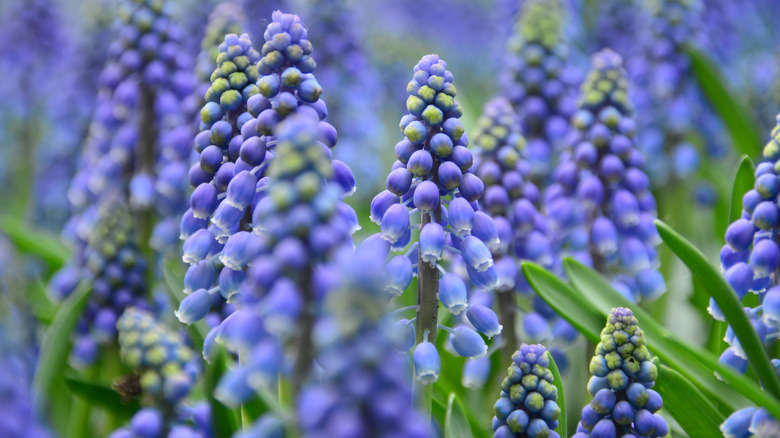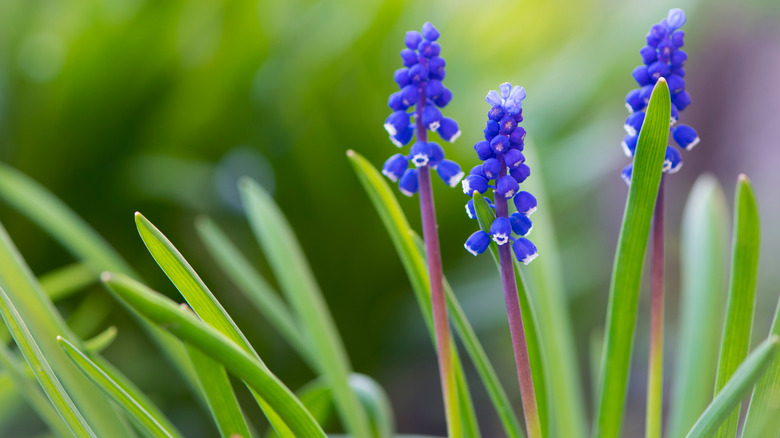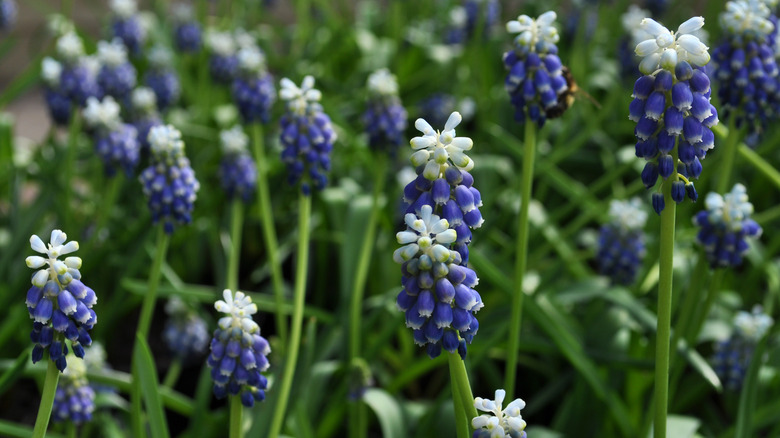How To Care For Grape Hyacinth
Grape hyacinths, often referred to by their botanical name, muscari, are a perennial flower that belong to the asparagus, or asparagaceae, family, according to The Spruce. They come in a variety of colors, the most common being blue, purple, and white, but some varieties come in pink and yellow. The plant is named due to the flower's shape, which resembles small little round grapes. While they're named after hyacinths and belong to the same family, they do not belong to the hyacinth genus.
Grape hyacinths are native to Europe, Asia, northern Africa, and the Mediterranean basin, and typically grow anywhere from 6 to 12 inches tall (via Gardener's Path). With over 40 species in the muscari genus, though, there's plenty of range in shape, size, and height. Grape hyacinths are a relatively low maintenance, easy-to-care-for perennial, and make a great addition to flower beds as spring bloomers. When they're done flowering, they look like ornamental grass for the remainder of the season. They are also completely nontoxic, notes SFGate.
How to use grape hyacinth in garden
Before planting grape hyacinths in your garden, you should first make sure you have the appropriate climate and location for them to grow to their full potential. As noted earlier, grape hyacinths can grow as perennials with the proper temperatures, which, according to The Spruce, roughly includes USDA hardiness zones 4 through 8. That being said, different varieties will have different needs. Grape hyacinths enjoy full sun, but they can tolerate low light levels; however, this may result in droopier or less vibrant blooms.
Other than that, grape hyacinths are pretty low-maintenance flowers, as long as their other needs are met. In terms of where to plant them, Garden Design recommends quite a few options, including growing them as a decorative border, in a meadow or along a forest path, under shrubs and trees, along a slope or hillside for a romantic effect, or in containers with other flowers. Alternatively, you can plant them underneath trees or shrubs, and once the flowers die off, you'll be left with attractive ornamental grass-like foliage decorating the base of your trees (per The Spruce).
Consider planting grape hyacinths with other early spring bloomers, which will create a lush, fragrant, colorful display come March. Appropriate flowers include phlox, tulips, dwarf irises, daffodils, lungworts, hellebores, bleeding hearts, and bergenias. Grape hyacinths would also look nice among any of their asparagaceae relatives.
How to grow grape hyacinth
Grape hyacinths can be grown in a few ways. You can visit your local garden center during the flower's growing season and look for a pre-grown individual that you can simply plant in your backyard. Another easy and popular way to grow grape hyacinths is by bulb. According to Gardener's Path, you should plant bulbs either in the late fall before the first frost or early spring after the last frost. Since the flowers are quite small when mature, plant them in groups of about 25.
When grown in a container or bed, grape hyacinths need to be dug up and separated every few years as the flower produces bulb offshoots and gets crowded. This is another great opportunity to grow new flowers. Simply dig up the plant and remove the offshoots using clean and sharp shears, then repot or replant.
You can also grow grape hyacinths from seed. You can harvest seeds from dried seed pods or purchase them at a garden center. At the end of fall or beginning of winter, place the seeds on a damp paper towel and add them to a plastic sandwich bag. Keep it in the fridge for about three months, and look for them to sprout anywhere from eight to 12 weeks in. Begin by planting them in starter seed pods or trays, and repot them in the ground or a container after the last frost in spring.
How to care for grape hyacinth
Caring for grape hyacinths is quite an easy task, and simply requires you to meet the basic needs of sun, water, food, and temperature. The Spruce points out that grape hyacinths love full sun. They also like to be moist in the spring but a little drier in the summer and fall, which should naturally happen as the weather and seasons change. In terms of climate, make sure they're given a chance to die off in the winter, which encourages spring blooms. Check your variety's specific hardiness zone for further guidance.
Grape hyacinths like to be planted in well-drained soil and prefer a slightly sandy mixture. Their only quirk in terms of soil preference is that they cannot be left in soggy soil, which can cause bulb rot and ruin your spring blooms. While muscari don't need to be fed, you can help encourage big, beautiful, vibrant flowers with a light sprinkling of bone meal, about ¼ cup, once in the fall.
Grape hyacinth varieties
According to Gardener's Path, there are more than 40 species in the muscari genus. Different varieties offer slightly different shapes, sizes, growth patterns and conditions, and colors. If a basic blue or purple grape hyacinth isn't your thing, maybe a white, pink, or even yellow one will be. Here are just a few of those varieties (via Better Homes & Gardens):
-
Muscari armeniacum 'Valerie Finnis' — This light blue flower was 2012's Flower Bulb of the year, blooms in mid to late spring, and grows to be roughly 6 inches tall (per Gardenia).
-
Muscari botryoides album — Also known as the white grape hyacinth or Pearls of Spain, this muscari variety bears lovely creamy white flowers that grow 6 inches tall.
-
Muscari azureum — This variety bears light periwinkle blooms, but is most identifiable for its unique shape. As Gardenia points out, the growth isn't constricted, which gives it a rounder shape.
-
Muscari 'Pink Sunrise' — This muscari species sports a delicate, soft pink flower, and is a very early spring bloomer, according to Home for the Harvest.
-
Muscari macrocarpum 'Golden Fragrance' — Native to Greece, this grape hyacinth variety uniquely bears golden-yellow flowers that only reach 5 inches tall, and bloom in the mid to late spring (via Gardenia).
How to repot grape hyacinth
Grape hyacinths can be grown in containers and brought indoors during the winter in colder climates. That being said, there are a few unique adjustments you'll need to make for potted muscari. One of those adjustments is occasionally repotting the flowers. As Gardener's Path points out, this is to prevent the flowers from becoming overcrowded, as well as to freshen up the soil with more nutrients for even more beautiful blooms.
Repotting grape hyacinths should be done roughly every three to four years. Begin by uprooting the plant. This can be accomplished by gently sliding the flower out of its pot, or using a spade to carefully dig it up. Pull apart the bulbs and remove any offshoots. Inspect the bulbs for signs of disease or infestation, and dispose of any mushy or rotting bulbs. Then, simply repot them. Larger, older bulbs do best in pots or container gardens, whereas small bulbs can either be tossed out or started in smaller pots.
